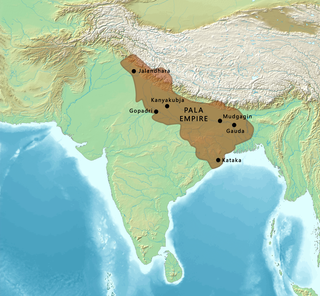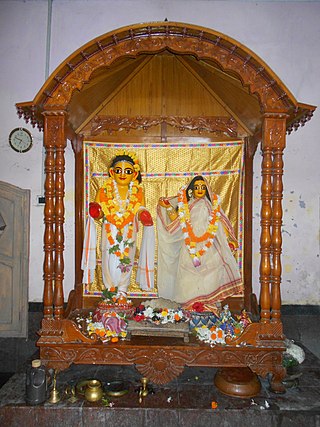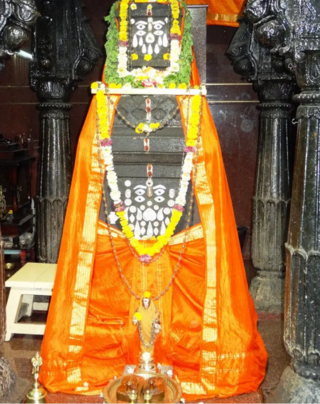Related Research Articles
Events in the year 1995 in the Republic of India.

The Pāla Empire was an imperial power during the post-classical period in the Indian subcontinent, which originated in the region of Bengal. It is named after its ruling dynasty, whose rulers bore names ending with the suffix Pāla. The empire was founded with the election of Gopāla as the emperor of Gauda in late eighth century CE. The Pala stronghold was located in Bengal and eastern Bihar, which included the major cities of Gauḍa, Vikramapura, Pāṭaliputra, Monghyr, Somapura, Ramavati (Varendra), Tāmralipta and Jagaddala.

The Bhagavata tradition, also called Bhagavatism, refers to an ancient religious sect that traced its origin to the region of Mathura. After its syncretism with the Brahmanical tradition of Vishnu, Bhagavatism became a pan-Indian tradition by the second century BCE, according to R.C. Majumdar.

Advaita Acharya was a companion of the founder of the Gaudiya Vaishnava movement, Chaitanya Mahaprabhu, and guru of Haridasa Thakur. He was born in the village of Nabagram in Laud, in 1434, some fifty years before Chaitanya, and spent most of his adult life in the town of Shantipur in Nadia with his wife and family. Advaita Acharya had six sons, Acyutananda Das, Krisna Mishra, Gopala Das, Balarama Das Mishra, Swarupa Das and Jagadisa Mishra.
Kāvya refers to the Sanskrit literary style used by Indian court poets flourishing between c.200 BCE and 1200 CE.
Gopala was the founder of the Pala dynasty, which was based in the Bengal region of the Indian subcontinent. The last morpheme of his name Pala means "protector" and was used as an ending for the names of all the Pala monarchs. Pala does not suggest or indicate any ethnic or caste considerations of the Pala dynasty. He came to power in later half of eighth century AD in Gaur/Gaud after being elected by a group of regional chieftains.

Gopala Bhatta Goswami (1503–1578) is one of the foremost disciples of the Vaishnava saint, Chaitanya Mahaprabhu, and a historical figure in the Gaudiya Vaishnava school of Hinduism. He was part of a group of Vaishnava devotees known collectively as the Six Goswamis of Vrindavan, who were influential in establishing the philosophical basis of the Gaudiya tradition in formalised writings.
Gopala Dasa (1721–1769) was a prominent 18th-century Kannada language poet and saint belonging to the Haridasa tradition. With other contemporary Haridasas such as Vijaya Dasa and Jagannatha Dasa, Gopala Dasa propagated the Dvaita philosophy of Madhvacharya in South India through Kirtans known as Dasara Padagalu with the pen-name "Gopala Vittala".He is Ganesa Amsha.

The Gopala Tapani Upanishad is a Sanskrit text, and one of the later Upanishads attached to the Atharvaveda. The Gopāla-Tāpanī is one of the four Tāpinī Upanishads.

Radha Ramana is one of the combined forms of the Hindu deities Radha and Krishna, besides their BankeBihari and Radha-Vallabha forms.

Jagannatha Dasa (1728–1809), a native of Manvi town in the Raichur district, Karnataka state, India, comes in the preceptorial line of Madhvacharya and is considered one of the notable Haridasa of Dvaita Vedanta of Madhva saint-poets of the Kannada language. He was a pupil of the great Sri Varadendra Tirtha.

Vennikkulam Gopala Kurup (1902–1980) was an Indian poet, playwright, translator, lexicographer and story writer of Malayalam. He was the author of a number of poetry anthologies, besides other works, and he translated Abhijnana Shakuntalam, Tulsi Ramayana, Tirukkuṛaḷ, the poems of Subramania Bharati and two cantos of The Light of Asia of Edwin Arnold into Malayalam. He also contributed in the preparation of a dictionary, Kairali Kosham. A recipient of the Odakkuzhal Award and Thirukural Award, Kurup received the Kerala Sahitya Akademi Award for Poetry in 1966. Sahitya Akademi honoured him with their annual award in 1974.
Kirttivarman, also known as Kīrtivarman, was a king of the Chandela dynasty of India. He ruled the Jejakabhukti region. He revived the Chandela power by defeating the Kalachuri king Lakshmi-Karna.
Kolluru Sree Krishna is an Indian marine geophysicist and former chief scientist at the National Institute of Oceanography, India. He is known for his studies on the evolution of the Indian Ocean and is an elected fellow of all the three major Indian science academies: Indian National Science Academy, Indian Academy of Sciences, and the National Academy of Sciences, India. The Council of Scientific and Industrial Research, the apex agency of the Government of India for scientific research, awarded him the Shanti Swarup Bhatnagar Prize for Science and Technology, one of the highest Indian science awards for his contributions to Earth, Atmosphere, Ocean and Planetary Sciences in 2001.
Gopal or Gouda is an Indian caste, from Odisha State in East India. Their traditional occupations include dairy farming, cattle herding, cultivation and carrying palanquins of deities. They also worked as Paikas (soldiers) under the kings. Gopal is the name of the milkmen or herdsmen caste in Odisha, which is known by other names in various parts of India.

Gopalakrusna Pattanayaka was an Odia poet & composer of Odissi music. His Odissi songs in various traditional ragas and talas are widely sung across the state, as well as other allied traditional artforms of Odisha, such as pala. The 20th-century Odissi musician, vocalist & binākara Apanna Panigrahi, also from the poet's hometown, was well-known for his renditions of Gopalakrusna's lyrics. Some of the most iconic Odissi songs, such as Syamaku Juhara Tara Premaku Juhara Ma, Jala Ani Jai Kali Kalindasutaku, Sangini Re Rasarangini Re, Kadamba Bane Bansi Bajila Re, Uthilu Ede Begi Kahinkire, Ki Nadare Prana Sangini, Manasija Mana Mohana are creations of Gopalakrusna. Many of his songs are popular abhinaya items in Odissi dance.
Rabi Mishra was an Indian actor who worked in Odia films, television serials, and theatres. He was known for his comedy characters. Mishra played various roles from negative to character artist in many TV series and films, but the character of Gopala Bhanda on the TV series Gopala Rahasya, which aired on DD Odia in 1994, gave him popularity.

Nath is an Indian romantic drama television series. It premiered on 23 August 2021 and ended on 12 October 2024, and it was aired on Dangal under the banner of Story Square Productions. It formerly starred Chahat Pandey, Arjit Taneja, Avinash Mishra, Ankit Gera, Aalisha Panwar, Arjun Singh Dalal, Kajal Chauhan and Piyush Sahdev.
The Gopalas, or Twelve Gopalas, were a group of 16th-century Indian missionaries who are credited with spreading Gaudiya Vaishnavism throughout Bengal. They were major disciples of the Gaudiya-Vaishnava saint Nityananda, who is considered to be an incarnation of Krishna's brother, Balarama.
References
- ↑ Datta, Amaresh (1988). Encyclopaedia of Indian Literature: devraj to jyoti, Volume 2. Gandhi Peace Foundation; Bharatiya Vidya Bhavan, Bombay. p. 1126.